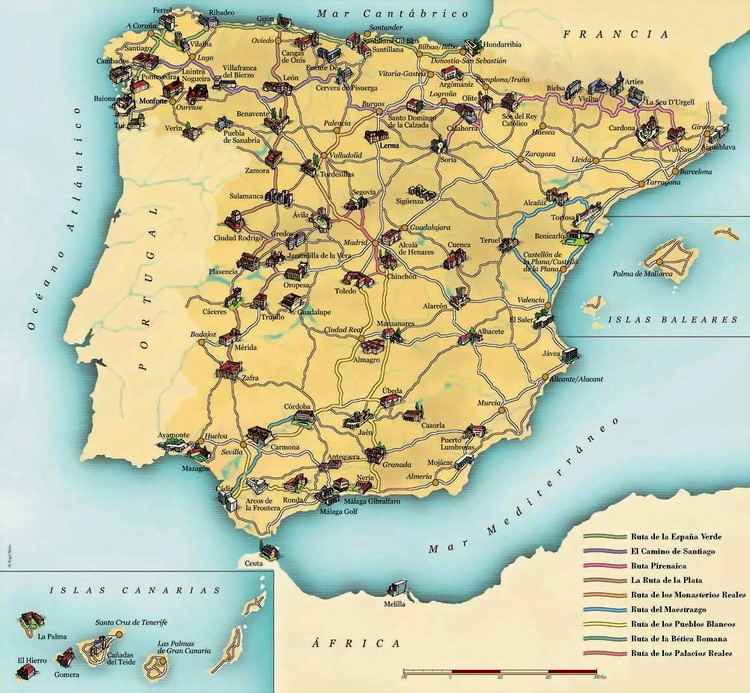Paradores of Spain: sleeping inside history
By Alex Mares | ANNO Media
Spain’s Paradores are not just places to stay. They’re a state-backed cultural project: living monuments where hospitality funds heritage. Born in 1928 with the opening of the Parador de Gredos in Ávila—an initiative championed by King Alfonso XIII to bring quality accommodation to scenic and historic areas—the network has grown across mainland Spain and the islands. Today the official site lists 98 Paradores in Spain (plus one affiliated property in Portugal), a tapestry of castles, palaces, monasteries and bold contemporary hotels woven into the country’s landscapes.

What makes Paradores special
Heritage, saved and served. The founding idea was simple and visionary: give disused or fragile historic buildings a sustainable future by welcoming travelers. That mission still defines the brand’s identity as a state-owned company dedicated to high-quality, place-rooted hospitality.
Architecture & sense of place. No two Paradores are alike. You might wake beneath ribbed Gothic vaults one night and beside the Atlantic in a glass-lined modernist icon the next. The Parador de Cádiz is a showcase of contemporary design with sea-wide terraces and views; elsewhere, cloisters, battlements and Plateresque façades set the mood.
Cuisine with roots. Each Parador’s restaurant champions its region—octopus in Galicia, game in Castile, extra-virgin oils in Andalusia—grounded in local products and sustainability commitments that are now central to the brand.
Sustainability, for real. In 2025 Paradores adopted a Sustainability Plan 2025–2028 aligned with the UN SDGs; earlier this year Spain’s tourism office highlighted the network’s goal of carbon neutrality (Scopes 1–2) by 2043 and an interim 30% cut by 2030. Paradores also announced that all properties are supplied with 100% renewable electricity through an agreement with Endesa.
Routes, not just rooms. “Rutas” are curated multi-night itineraries—Green Spain along the Cantabrian coast; World Heritage cities around Madrid; the ancient Silver Route—making it easy to string several Paradores into a narrative journey.
Four emblematic stays
- Santiago de Compostela (Hostal dos Reis Católicos). A 16th-century royal hospital for pilgrims on the Plaza do Obradoiro, now one of the grand dames of European hotels—and still honoring pilgrim tradition.
- Granada (Parador de Granada). Within the Alhambra complex itself, housed in a former Nasrid/Franciscan ensemble—wake up in the palace-gardens’ quiet.
- Cardona (Catalonia). A 9th-century fortress-castle high above the valley, all stone ramparts, Romanesque church and wide Pyrenean views.
- Cádiz (Andalusia). A sleek oceanfront Parador of glass and light—proof the brand embraces the future as confidently as it preserves the past.
How to plan a Paradores trip (quick wins)
- Join “Amigos de Paradores” (free): get an Amigo Price (≈5% off online), a welcome drink, and earn points toward free nights; there’s also a 15% “Gastroparada” lunch discount when you’re on the road between stays.
- Look for seasonal deals. Examples include “Días Dorados” (10% off for travelers 55+) and periodic route or seasonal promotions.
- Build a narrative. Pair three to five nights along a theme—Cádiz → Arcos de la Frontera → Córdoba → Granada for Andalusian light and Moorish heritage; or León → Cangas de Onís → Santillana for Romanesque stones and green Atlantic Spain. (Use the official Rutas as your backbone.)
 Why Paradores are worth it—for travelers and for Spain
Why Paradores are worth it—for travelers and for Spain
Staying in a Parador turns travel into stewardship: your room key helps finance conservation, local food networks, fair procurement and year-round jobs in places that need them. For you, it’s the opposite of generic: breakfast in a cloister, sunset on a battlement, contemporary design over the Atlantic—Spain, distilled.

